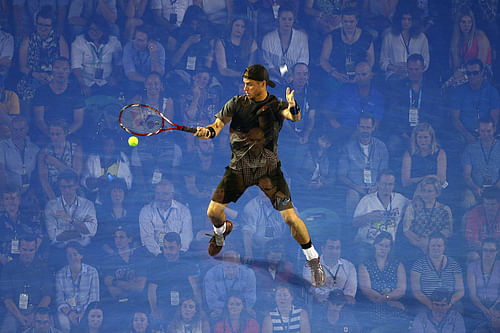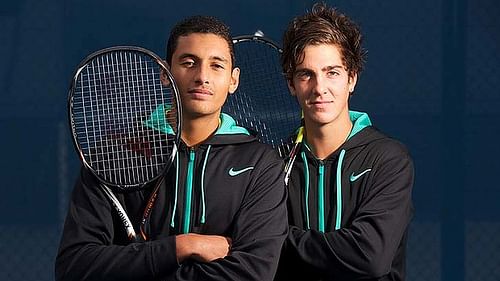
Australian Open Diary: Charge of the Aussie Brigade

Positive start for Aussie players
What is the most reliable sign of a good start for Australian tennis at their home Grand Slam?
Is it the sight of young guns Nick Kyrgios and Thanasi Kokkinakis coming through their opening encounters in curiously parallel, tough 5-setters? Or is it ol’ rusty Lleyton Hewitt hustling his way to victory on Rod Laver Arena? Or how about Casey Dellacqua playing true to the good form she has shown over the last year? Or should we just be grateful for Sam Stosur powering her way though the first round, in what is usually a jinxed part of the season for her?
Well, all the above, and more, happened for the Australians over the first two days of this year’s Grand Slam, making the first round an unqualified success for home talent. In terms of numbers, ten Australians figured in the men’s main draw, and seven of them have made it through to the second round. This is in comparison to last year, when only three of nine survived their first round encounter. On the women’s side, four out of eight players have lived to fight on in the second round.
The young brigade

More than these figures, it is the profiles of these players that makes the future of Australian tennis look promising. The average age of the Australian men in this year’s Open is only 23. A few of them have already been marked for greatness, and even have a couple of big scalps to their name. Prominent among them are, of course, Kyrgios, Tomic and Kokkinakis.
The interesting thing about the Australian tennis system is the current ethnic profile of the players it seems to produce. Gone are the days when Australian tennis meant tanned skin and headbands, a la Pat Cash, or pony tails and sun block, a la Pat Rafter, or even the punk rocker of a Lleyton Hewitt. Today’s emerging players from Down Under flash their bling, swagger like rap stars, and speak in unconventional Aussie accents. Tomic was born in Germany to Croatian parents, while Kyrgios and Kokkinais have Greek roots. Even Matosevic emigrated as a youngster from Bosnia. However, all these players learnt their tennis from scratch in Australia, and are without doubt, products of the system here.
More than anything else, this is a testimony to an increasingly multi-cultural setup in Australia, and a tennis environment that does not discriminate on any grounds. Of course, with reference to Kyrgios and Kokkinakis, this might just be an extension of the traditional Mediterranean influence on Australian tennis. Think no further than Mark ‘the Scud’ Philippoussis, or even Marcos Baghdatis’ fan support at Melbourne.
Acceptance of players from other nationalities

The women’s tour in Australia has an even more interesting phenomenon currently – that of the ‘tennis import’. These are players like Ajla Tomljanovic and Daria Gavrilova, who obtained Australian citizenship primarily for the sake of furthering their already established tennis credentials. This trend possibly began with players like Slovakian-born Jarmila Gajdosova and the Russian Rodionova sisters. Hushed whispers continue to make the rounds on whether these are ‘poaching’ moves instigated by national tennis boards. The lack of home-grown talent makes it obvious how the Australian scene could benefit from such naturalized tennis players. Beyond Stosur and Dellacqua, there does seem to be a dearth of national talent currently.
But sometimes, this could be just the case of a young, talented player trying to access the best facilities, widest range of opportunities, and in the process, maximize career results. Tomljanovic’s story seems to be along these lines. The 21-year old Croat caused an uproar when she shifted national allegiance before last year’s US Open. In fact, she is yet to obtain an Australian passport, and according to WTA rules, cannot represent Australia in any non-Grand Slam event.
Today, however, the crowd in Rod Laver Arena saw no reason to distinguish between ‘home-grown’ and ‘imported’ talent, as Tomljanovic came from behind to beat USA’s Shelby Rogers in three sets in her first round match. The Aussie fanatics were out in full force, and were as voluble in their support for Tomljanovic, as they were for Hewitt in the immediately preceding match.
In the post-match, on-court interview, Todd Woodbridge congratulated Tomljanovic on her first win for Australia in her new home country. The brand-new Australian was emotional in her reply. This was a young woman who was seeing her sacrifices proved worthwhile on the road to her dreams. She thanked the Aussie fanatics for their support, and hoped they would return for her next match. The fans in yellow cheered back. She was already one of them, she was always one of them.
Any good reason to yell out, “Aussie, Aussie, Aussie! Oi, Oi, Oi!”